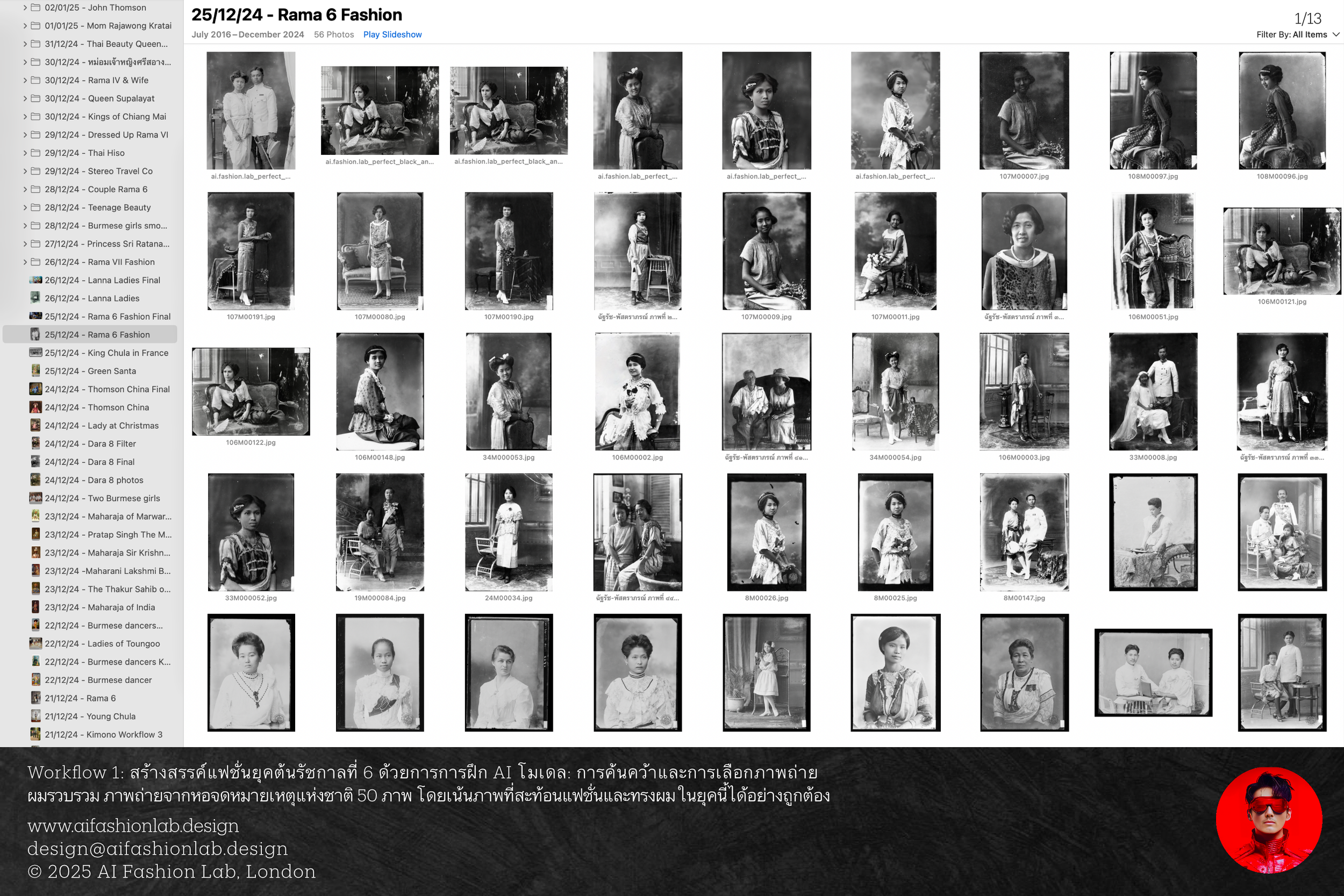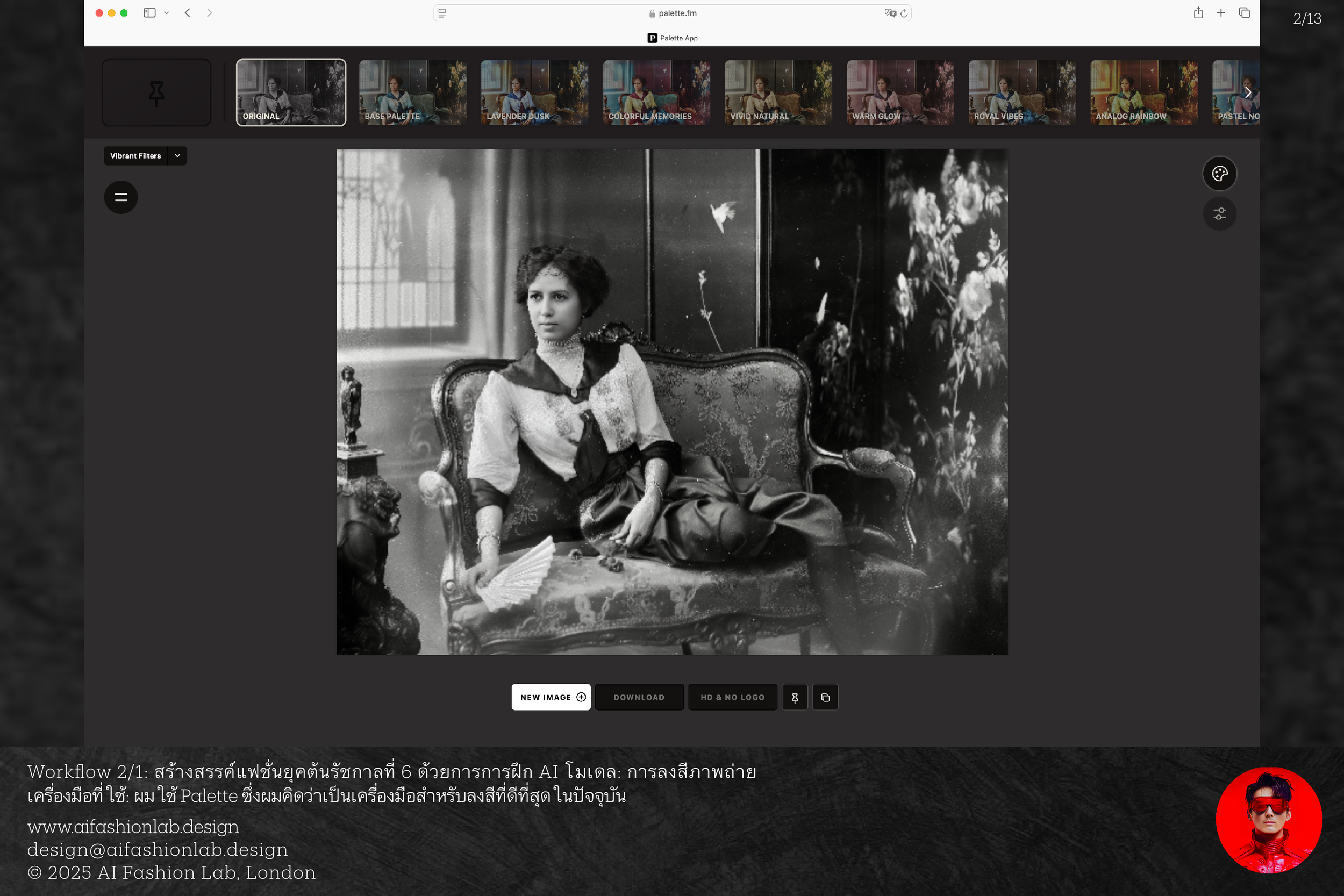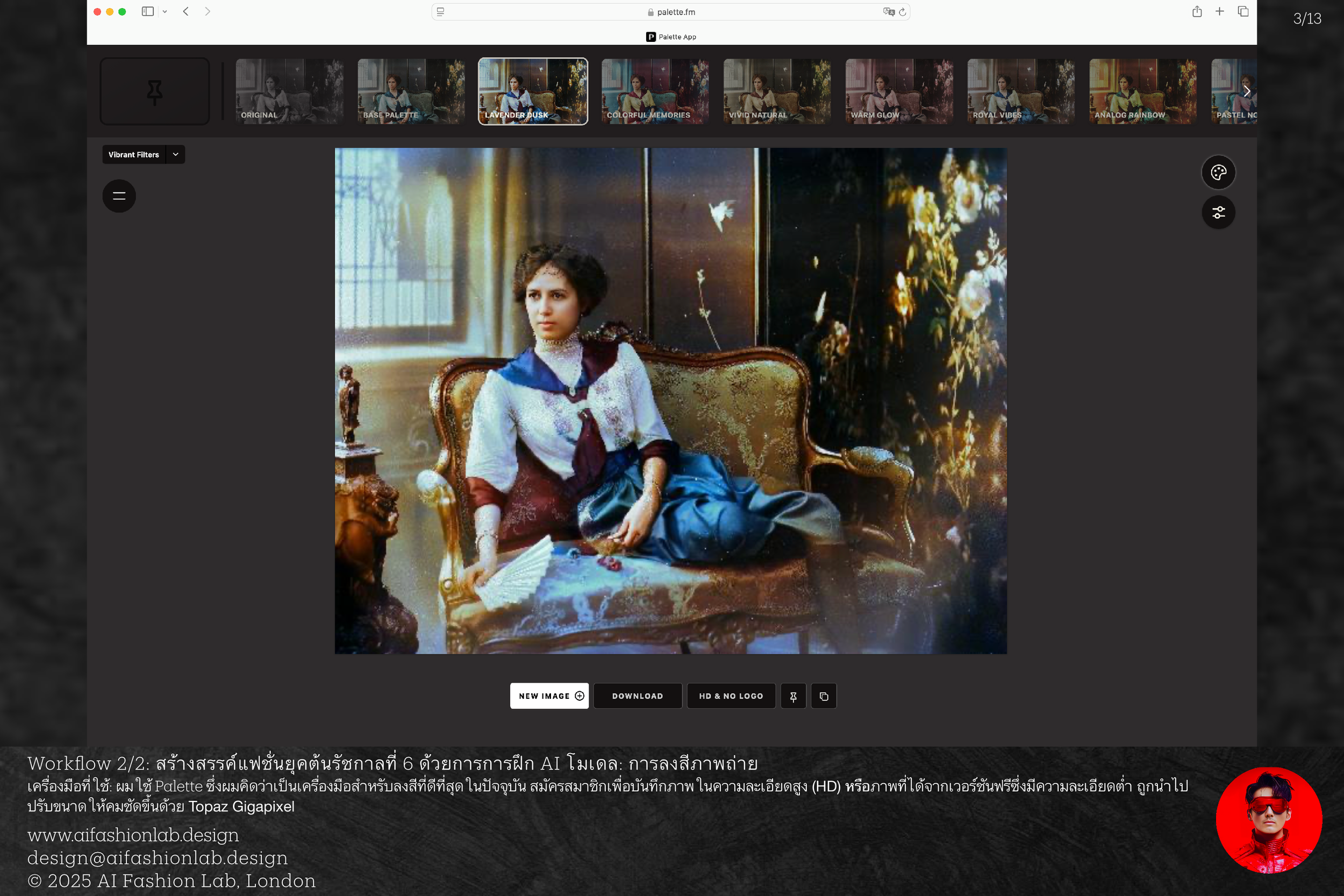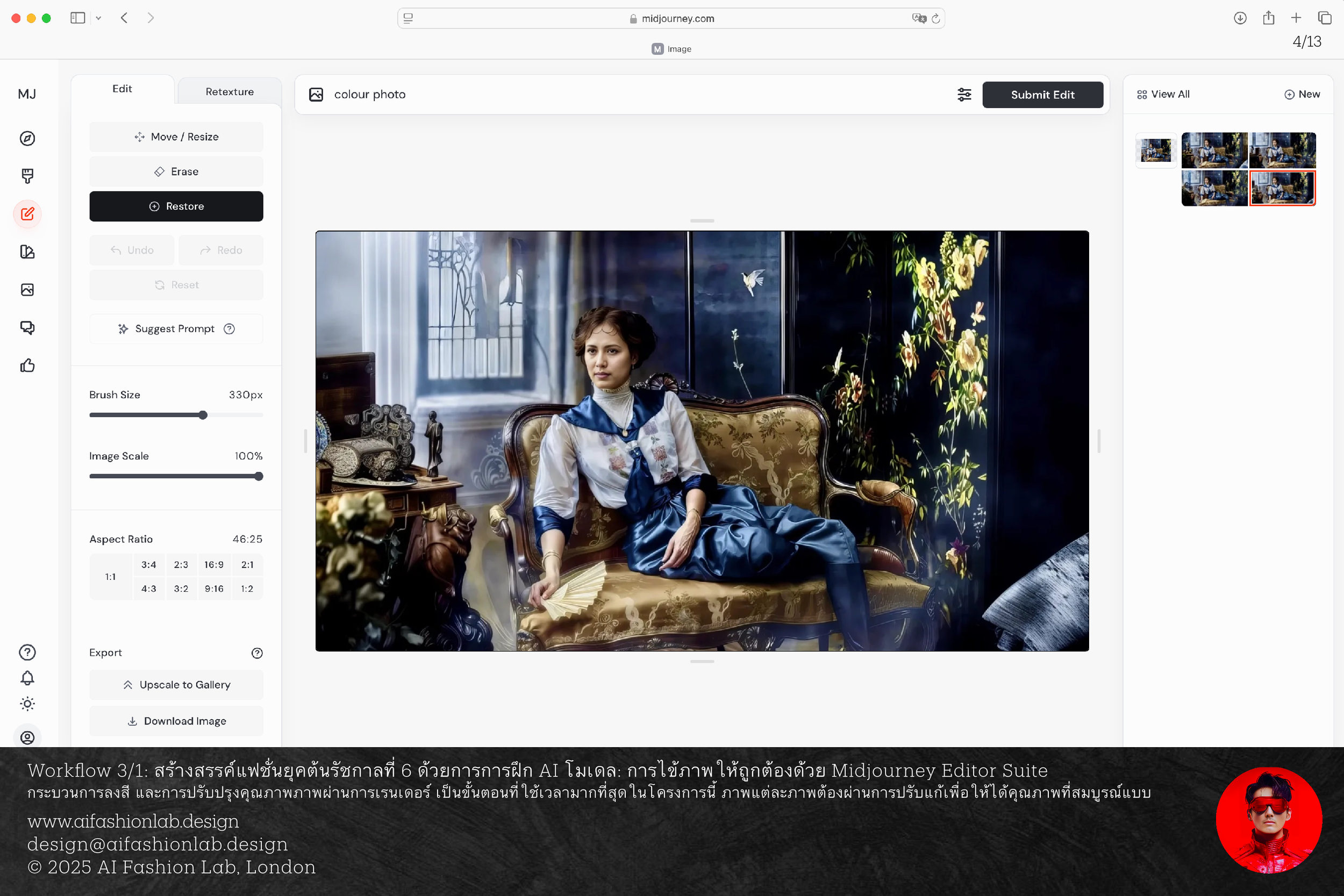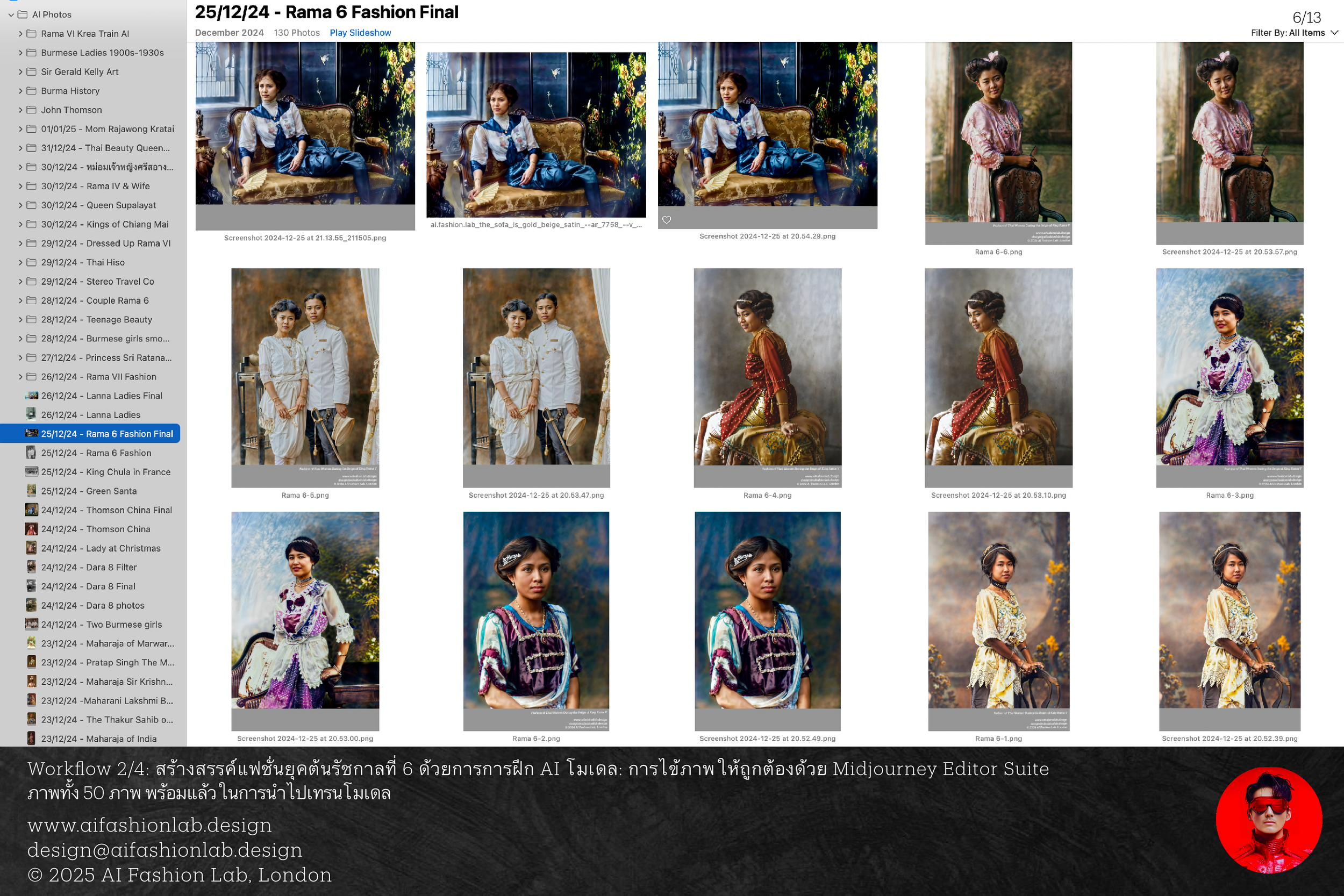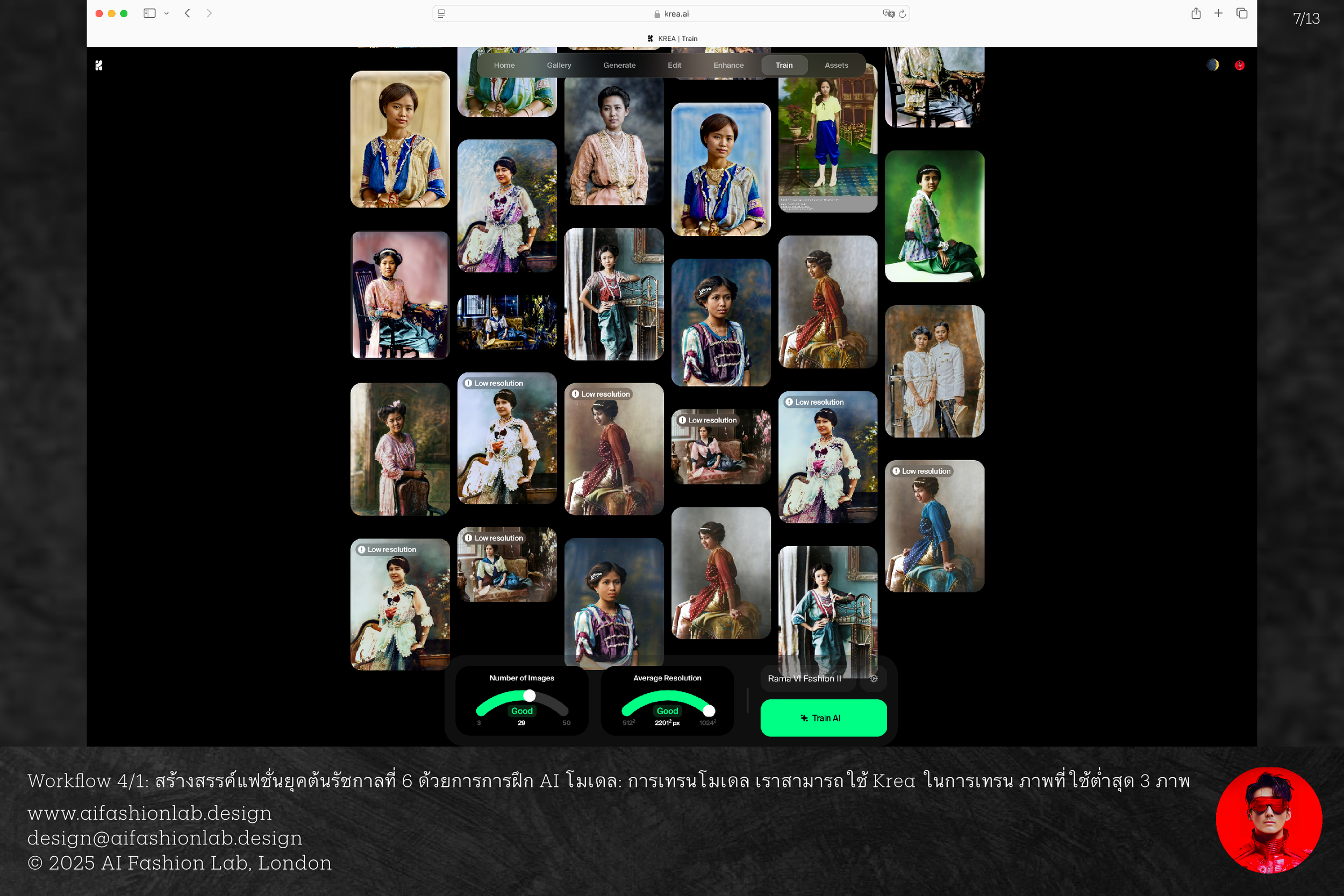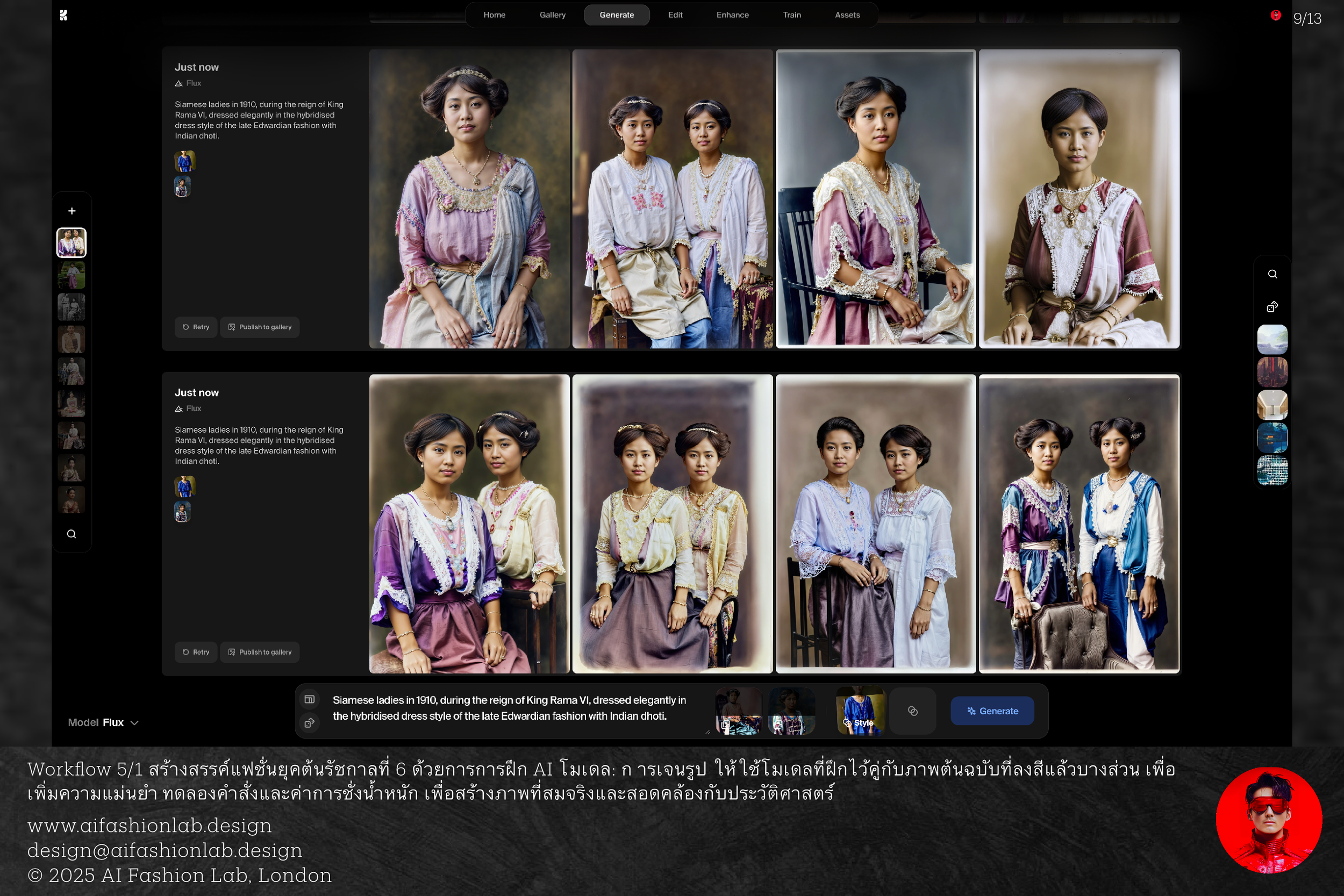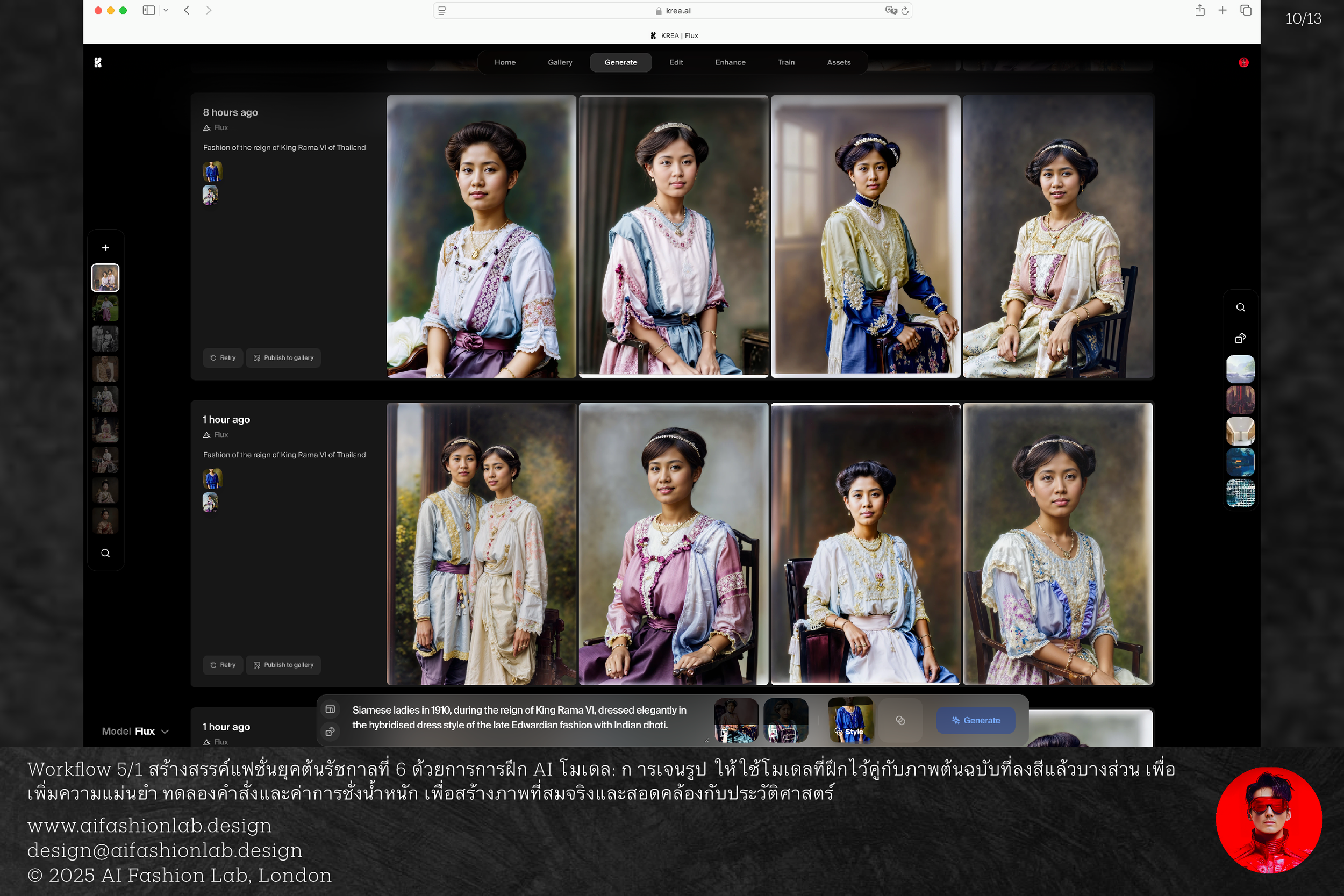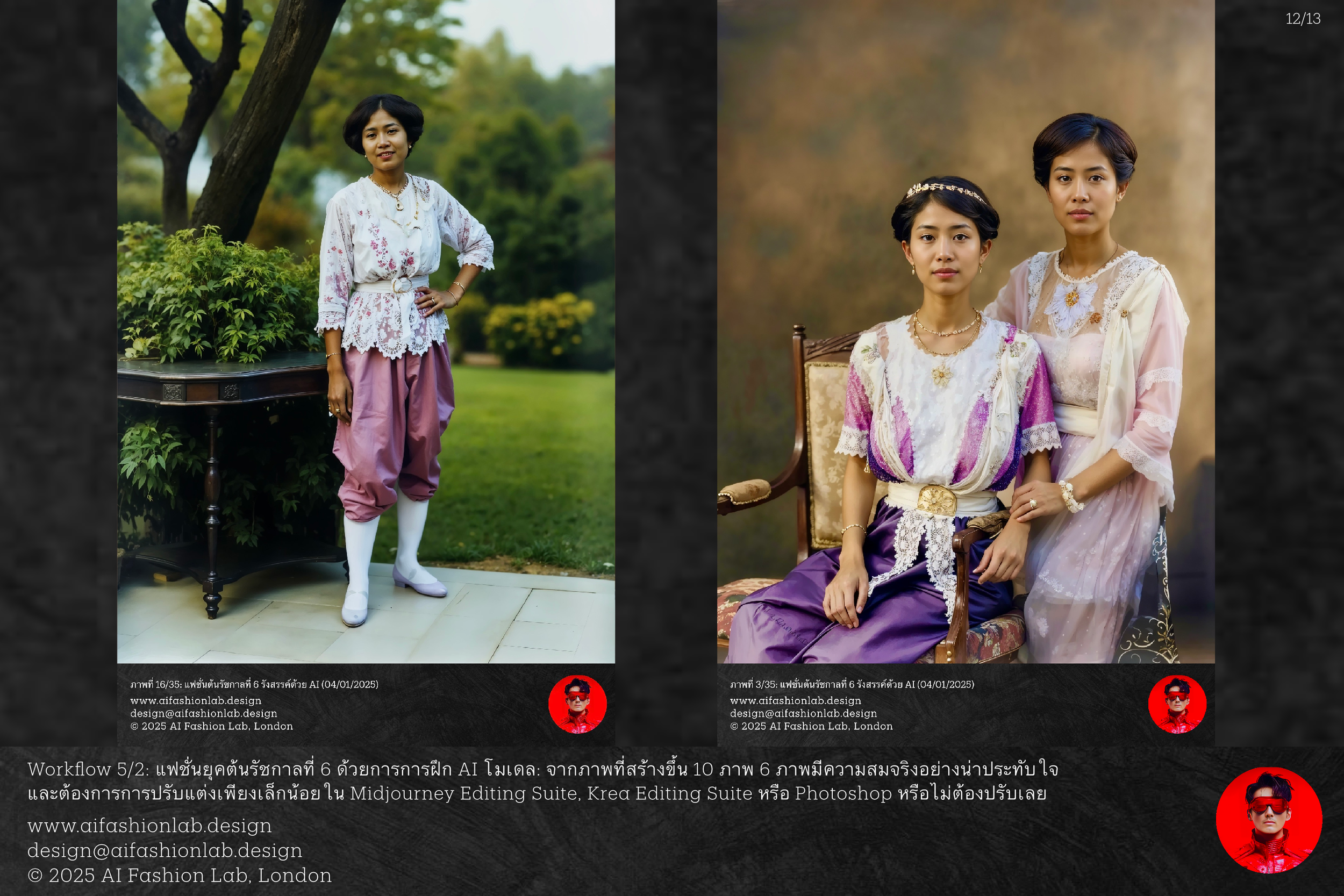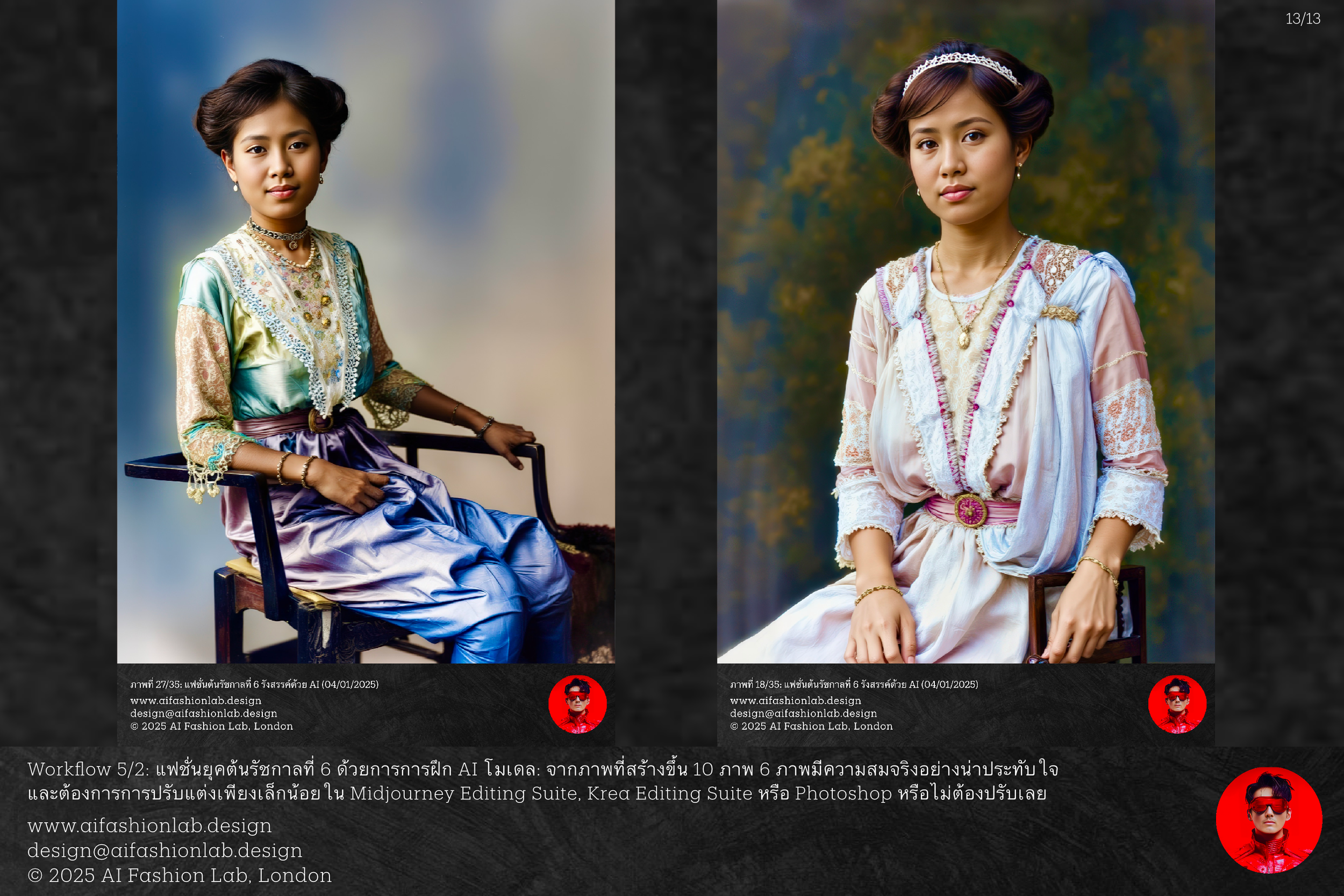Recreating Early Rama VI Era Fashion (1910–1920) by Training an AI Model: A Journey of Patience and Precision
Recreating the fashion of the early Rama VI era of Thailand (1910–1920) through AI is both a creative and historically significant endeavour. The era’s unique blend of Thai and Western styles posed significant challenges, but the results are immensely rewarding. In this article, I’ll share my workflow, breaking it down step-by-step, to showcase how I trained an AI model to authentically recreate this fascinating period of Thai fashion.
Recreating Early Rama VI Era Fashion (1910–1920) by Training an AI Model: A Journey of Patience and Precision
Recreating the fashion of the early Rama VI era of Thailand (1910–1920) through AI is both a creative and historically significant endeavour. The era’s unique blend of Thai and Western styles posed significant challenges, but the results are immensely rewarding. In this article, I’ll share my workflow, breaking it down step-by-step, to showcase how I trained an AI model to authentically recreate this fascinating period of Thai fashion.
The early Rama VI era was characterised by a hybridisation of styles. Women wore chong kraben (a traditional lower garment) paired with tailored blouses inspired by Edwardian fashion but adapted to Thai traditions. Accessories such as lace details, belts, and jewellery, combined with upswept hairstyles adorned with combs or floral accents, highlighted the era’s elegance. These nuanced elements required an AI model trained with patience and meticulous historical references to accurately capture the essence of this period.
Workflow Process
1. Preparation and Research
Research and Photo Selection: I curated 50 archival digital photographs from the National Archives of Thailand, focusing on images that accurately represented the era’s fashion and hairstyles.
Criteria: The digital photographs needed to depict real individuals and exhibit consistency in their costumes and styling.
2. Colourisation
Tool Used: I used Palette, which I consider one of the best colourisation engines available.
Subscribed to save high-definition (HD) images.
Free, lower-resolution images were upscaled to HD using Topaz Gigapixel.
The Most Time-Consuming Step:
The colourisation process, along with enhancing and rendering each image, took the most time. Each photograph required careful adjustments to ensure lifelike quality.
Challenges:
Colour bleeding from subjects into the background required manual corrections.
Manual Adjustments:
Used tools such as MidJourney Editor and Krea Editor to correct colour inaccuracies and refine images further.
3. Image Rendering and Enhancement
Enhancement Tools: To achieve lifelike quality, I rendered and enhanced the images using:
Magnific
Krea Enhance Suite
4. AI Model Training
Platform and Model: I utilised the Krea platform and trained the model on the ComfyUI Flux Dev base model, which provided a strong foundation.
Dataset:
Used all 50 curated images for training to ensure a comprehensive understanding of early Rama VI-era fashion.
Challenges:
AI struggles to interpret chong kraben. To address this, I used the term "Indian dhoti" in prompts, as AI recognises its similarities more readily.
Adjusting Parameters:
Adjusted weights in the Krea platform, starting at 0.40 (0.00–1.00), and experimented for optimal results.
5. Image Generation
Process:
Combined the trained model with a few original colourised images to ensure accuracy.
Experimented with prompts and weights to generate historically authentic results.
Evaluation:
Out of every 10 generated images, 6 were impressively realistic and required minimal or no adjustments.
Supporting AI Platforms and Creativity
Throughout this process, I’ve relied on innovative AI tools that make these creations possible. Tools like Midjourney, Palette, Krea, and Topaz Gigapixel are the result of extraordinary creativity and technical expertise. I strongly encourage fellow creatives to subscribe to and pay for these platforms. By doing so, we support the talented individuals who work tirelessly to develop these tools, allowing us to bring our creative ideas to life with efficiency and precision. Supporting their work ensures these platforms continue to thrive and improve, benefitting the entire creative community.
Final Results and Reflections
This project demonstrates that while recreating a specific historical period requires dedication, the payoff is immense. By carefully integrating Thai and Western elements, the AI-generated images successfully capture the elegance, authenticity, and hybridised spirit of early 20th-century Thai fashion.
I hope this article has provided insight into the process and challenges involved in training an AI model for such a specific historical project. I’m excited to share these results and welcome your feedback on how well the AI has succeeded in bringing this era to life.
สร้างสรรค์แฟชั่นยุคต้นรัชกาลที่ 6 (พ.ศ. 2453–2463) ด้วยการการฝึก AI โมเดล: การเดินทางแห่งความอดทนและความพิถีพิถัน
การสร้างสรรค์แฟชั่นในยุคต้นรัชกาลที่ 6 (พ.ศ. 2453–2463) ด้วยการใช้ AI ถือเป็นโครงการที่สร้างสรรค์และมีความสำคัญทางประวัติศาสตร์ เอกลักษณ์ที่โดดเด่นของแฟชั่นในยุคนี้ ซึ่งผสมผสานระหว่างสไตล์ไทยและตะวันตก ทำให้เกิดความท้าทายอย่างมาก แต่ผลลัพธ์ที่ได้ก็คุ้มค่ามากเช่นกัน ในบทความนี้ ผมจะแบ่งปันขั้นตอนการทำงาน โดยอธิบายทีละขั้นตอนว่าผมใช้ AI เพื่อสร้างสรรค์แฟชั่นในยุคประวัติศาสตร์ที่น่าหลงใหลนี้ได้อย่างไร
แฟชั่นในยุคต้นรัชกาลที่ 6 มีความโดดเด่นด้วยการผสมผสานระหว่างสไตล์ตะวันตกและไทย ผู้หญิงในยุคนั้นมักสวม โจงกระเบน (เครื่องแต่งกายท่อนล่างแบบไทย) คู่กับเสื้อเบลาส์ที่ได้รับแรงบันดาลใจจากแฟชั่นยุคเอ็ดเวอร์เดียน แต่ปรับให้เข้ากับรสนิยมและวิถีชีวิตแบบไทย รายละเอียดอย่างลูกไม้ เข็มขัด และเครื่องประดับ เพิ่มความสง่างามให้กับชุด ขณะที่ทรงผมสะท้อนถึงช่วงเปลี่ยนผ่าน โดยมวยผมที่ตกแต่งด้วยหวีประดับหรือดอกไม้ แสดงถึงความงามที่ผสมผสานทั้งวัฒนธรรมไทยและตะวันตก
กระบวนการทำงาน
1. การเตรียมงานและการค้นคว้า
การค้นคว้าและการเลือกภาพถ่าย: ผมรวบรวม ภาพถ่ายดิจิตอลจากหอจดหมายเหตุแห่งชาติ 50 ภาพ โดยเน้นภาพที่สะท้อนแฟชั่นและทรงผมในยุคนี้ได้อย่างถูกต้อง
เกณฑ์การคัดเลือก: ภาพดิจิตอลที่เลือกต้องเป็นบุคคลจริง และต้องมีความสอดคล้องในรูปแบบชุดและสไตล์โดยรวม
2. การลงสี
เครื่องมือที่ใช้: ผมใช้ Palette ซึ่งผมคิดว่าเป็นเครื่องมือสำหรับลงสีที่ดีที่สุดในปัจจุบัน
สมัครสมาชิกเพื่อบันทึกภาพในความละเอียดสูง (HD)
ภาพที่ได้จากเวอร์ชันฟรีซึ่งมีความละเอียดต่ำ ถูกนำไปปรับขนาดให้คมชัดขึ้นด้วย Topaz Gigapixel
กระบวนการที่ใช้เวลามากที่สุด:
กระบวนการลงสี และการปรับปรุงคุณภาพภาพผ่านการเรนเดอร์ เป็นขั้นตอนที่ใช้เวลามากที่สุดในโครงการนี้ ภาพแต่ละภาพต้องผ่านการปรับแก้เพื่อให้ได้คุณภาพที่สมบูรณ์แบบ
ความท้าทาย:
สีที่ลงอาจเลอะหรือไหลออกจากตัวแบบไปยังพื้นหลัง ซึ่งต้องแก้ไขด้วยตนเอง
การแก้ไขด้วยมือ:
ใช้เครื่องมืออย่าง MidJourney Editor และ Krea Editor เพื่อแก้ไขความผิดพลาดด้านสีและปรับแต่งภาพให้สมบูรณ์
3. การเรนเดอร์และการปรับปรุงคุณภาพ
เครื่องมือที่ใช้: เพื่อให้ได้ภาพที่สมจริง ผมใช้:
Magnific
Krea Enhance Suite
4. การฝึก AI โมเดล
แพลตฟอร์มและโมเดลที่ใช้: ผมใช้ Krea platform และฝึกโมเดลบนฐาน ComfyUI Flux Dev base model ซึ่งเป็นรากฐานที่แข็งแกร่ง
ชุดข้อมูล:
ใช้ภาพทั้งหมด 50 ภาพในการฝึก เพื่อให้ AI เข้าใจแฟชั่นในยุคต้นรัชกาลที่ 6 ได้อย่างครอบคลุม
ความท้าทาย:
AI มีปัญหาในการเข้าใจ โจงกระเบน เนื่องจากความเฉพาะตัวและโครงสร้างของมัน ผมจึงใช้คำว่า "Indian dhoti" ในคำสั่ง ซึ่งช่วยให้ AI เข้าใจได้ง่ายขึ้น
การปรับพารามิเตอร์:
ปรับค่าการชั่งน้ำหนัก (Weights) ใน Krea โดยเริ่มต้นที่ 0.40 (0.00–1.00) และทดลองเพื่อให้ได้ผลลัพธ์ที่ดีที่สุด
5. การสร้างภาพ
กระบวนการ:
ใช้โมเดลที่ฝึกไว้คู่กับภาพต้นฉบับที่ลงสีแล้วบางส่วน เพื่อเพิ่มความแม่นยำ
ทดลองคำสั่งและค่าการชั่งน้ำหนัก เพื่อสร้างภาพที่สมจริงและสอดคล้องกับประวัติศาสตร์
การประเมินผล:
จากภาพที่สร้างขึ้น 10 ภาพ 6 ภาพมีความสมจริงอย่างน่าประทับใจ และต้องการการปรับแต่งเพียงเล็กน้อยหรือไม่ต้องปรับเลย
สนับสนุนแพลตฟอร์ม AI และความคิดสร้างสรรค์
ในกระบวนการนี้ ผมได้ใช้เครื่องมือ AI ที่มีนวัตกรรมสูงซึ่งทำให้การสร้างสรรค์เหล่านี้เป็นไปได้ เช่น Midjourny, Palette, Krea, และ Topaz Gigapixel ซึ่งเป็นผลลัพธ์จากความคิดสร้างสรรค์และความเชี่ยวชาญทางเทคนิค ผมอยากเชิญชวนทุกคนให้ สนับสนุนแพลตฟอร์มเหล่านี้ด้วยการสมัครสมาชิกและชำระค่าบริการ การสนับสนุนนี้ไม่เพียงแต่ช่วยให้เครื่องมือเหล่านี้พัฒนาต่อไป แต่ยังเป็นการสนับสนุนผู้พัฒนาที่ทำงานอย่างหนักเพื่อสร้างสรรค์สิ่งที่ยอดเยี่ยมให้เราได้ใช้งานอีกด้วย
ผลลัพธ์และข้อคิด
โครงการนี้แสดงให้เห็นว่า แม้การสร้างสรรค์แฟชั่นในยุคประวัติศาสตร์ที่เฉพาะเจาะจงจะต้องอาศัยความอดทนและความพิถีพิถัน แต่ผลลัพธ์ที่ได้ก็คุ้มค่าอย่างมาก การผสมผสานระหว่างสไตล์ไทยและตะวันตกทำให้ภาพที่สร้างด้วย AI สามารถถ่ายทอดความสง่างาม ความถูกต้อง และจิตวิญญาณของแฟชั่นในช่วงต้นศตวรรษที่ 20 ได้อย่างสมบูรณ์แบบ
ผมหวังว่าบทความนี้จะช่วยให้ทุกคนเห็นถึงกระบวนการและความท้าทายที่เกี่ยวข้องกับการฝึกโมเดล AI สำหรับโครงการประวัติศาสตร์ที่เฉพาะเจาะจงเช่นนี้ ผมรู้สึกตื่นเต้นที่จะแบ่งปันผลลัพธ์และขอรับฟังความคิดเห็นจากทุกคนเกี่ยวกับความสำเร็จของ AI ในการนำเสนอยุคสมัยอันงดงามนี้ครับ
#aifashionlab #AI #aiartist #aiart #aifashion #aifashiondesign #aifashionstyling #aifashiondesigner #fashion #fashionhistory #historyoffashion #fashionstyling #fashionphotography #digitalfashion #digitalfashiondesign #digitalcostumedesign #digitaldesign #digitalaiart #promptography #promptographer #prompts #fashionpromptography
